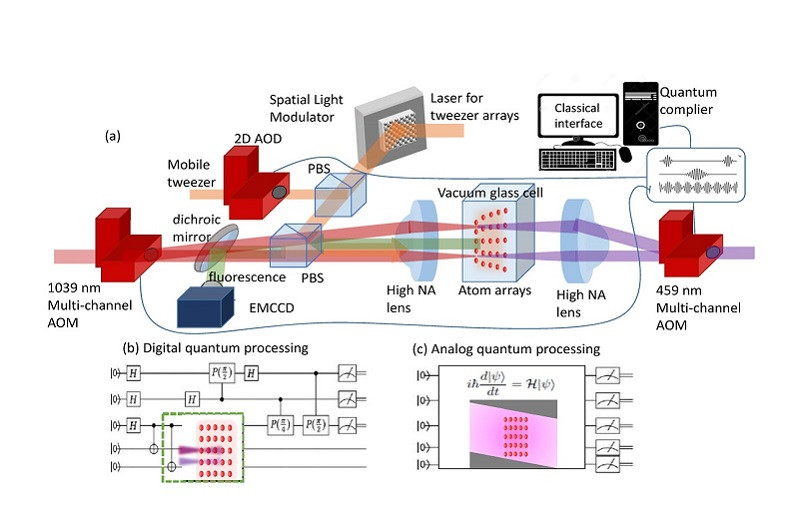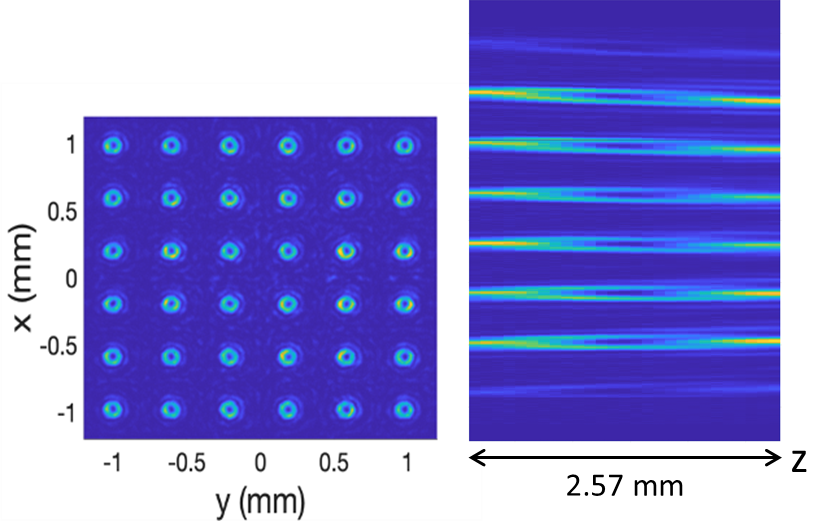第一列
The goal is to develop a two-dimensional cesium atom arrays for the realization of a 64-qubit digital quantum processor and a 200-qubit analog quantum process. We want to improve the two-qubit gate fidelity to > 0.99 and to develop the scalable technology for large-scale quantum gate operation in order to implement quantum algorithm. This may offer great opportunities for local researcher to study the frontier quantum computing and simulation problems based on a home-built programmable quantum computer.

(a) Schematic diagram of quantum computer based on two-dimensional atom arrays. A dipole trap laser is diffracted by a spatial light modulator to form tweezer arrays inside the vacuum glass cell. Each tweezer traps a single atom. One 2D acousto-optic deflector control a mobile tweezer to move the atom to form an atom pair with a closer distance. Two lasers excite the atom pair to Rydberg state which implement the controlled-phase two-qubit gate. Another Raman laser (not shown) excites single atoms to realize single-qubit gate. Quantum algorithm is running by a quantum complier which links the classical interface with the quantum registers. An electron-multiplied CCD camera records the results through atomic fluorescence.
(b) If qubits are individual addressed, the system works as a digital quantum processor.
(c) If all qubits are addressed by the same Rydberg lasers, one can implement an analog quantum processor with its Hamiltonian controlled by the laser and atom parameters.
-
Co-PI
-
Yu-Ju Lin (Academia Sinica)
-
Chao-Kuei Lee (National Sun Yat-sen University)
-
Hsiang-Hua Jen (Academia Sinica)
-
Yang-hao Chan (Academia Sinica)
Two-dimensional hollow-beam optical tweezer arrays
- We generate two-dimensional hollow-beam optical tweezer arrays which can trap atoms both in the ground and Rydberg states.
- Most atom array experiments utilize optical tweezers of red-detuned, focused Gaussian beams, which can trap atoms in the ground state but repel those in Rydberg state. Thus, one needs to turn off the tweezers during quantum gate operation. Turning off and on the tweezers can cause atom heating and reduce the circuit depth of quantum operations. Hollow-beam tweezers may reduce this problem. Besides, they can be used to trap atoms in different Rydberg states to realize quantum simulation of exotic spin models.
- This technology will be used in the qubit buffer zone for the quantum processor and quantum simulation experiments.

Left: 6´6 hollow-beam optical tweezers.
Right: Intensity profile of the hollow-beam tweezers along the propagating axis. High NA objective will be used to focus the beam to 1 mm for single-atom trapping.